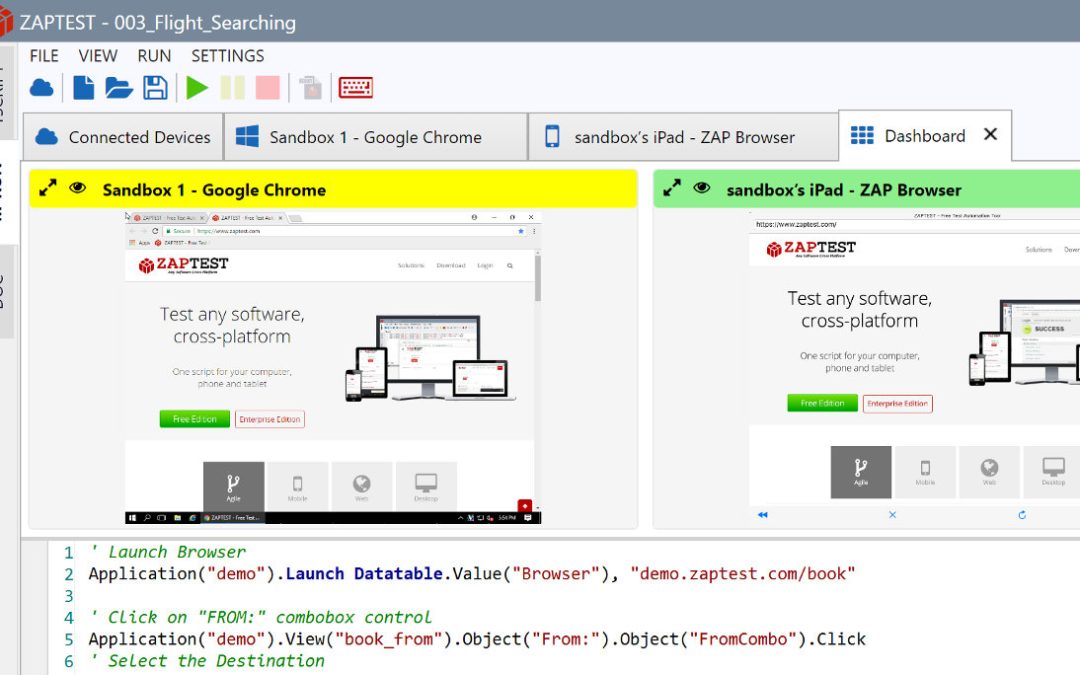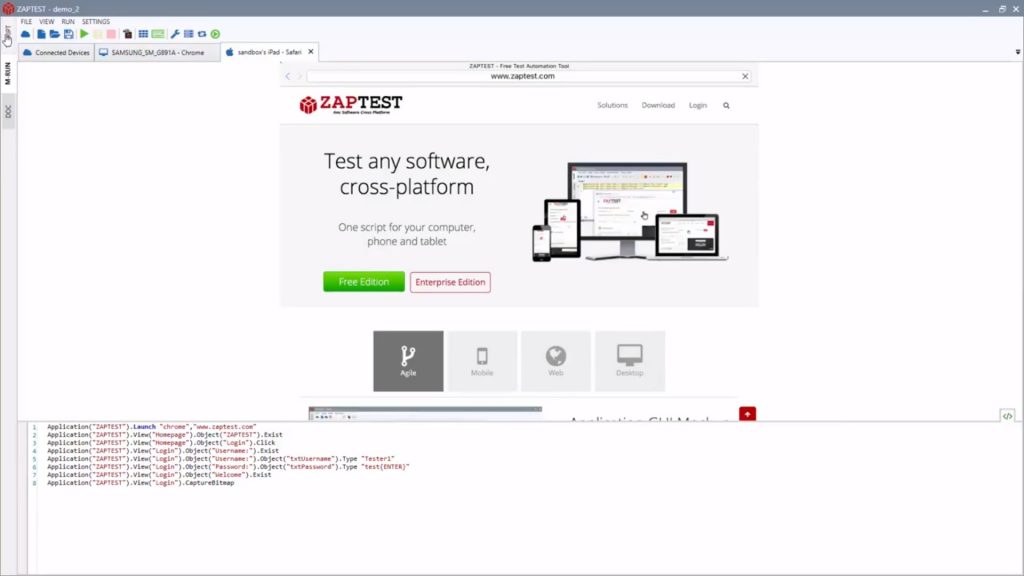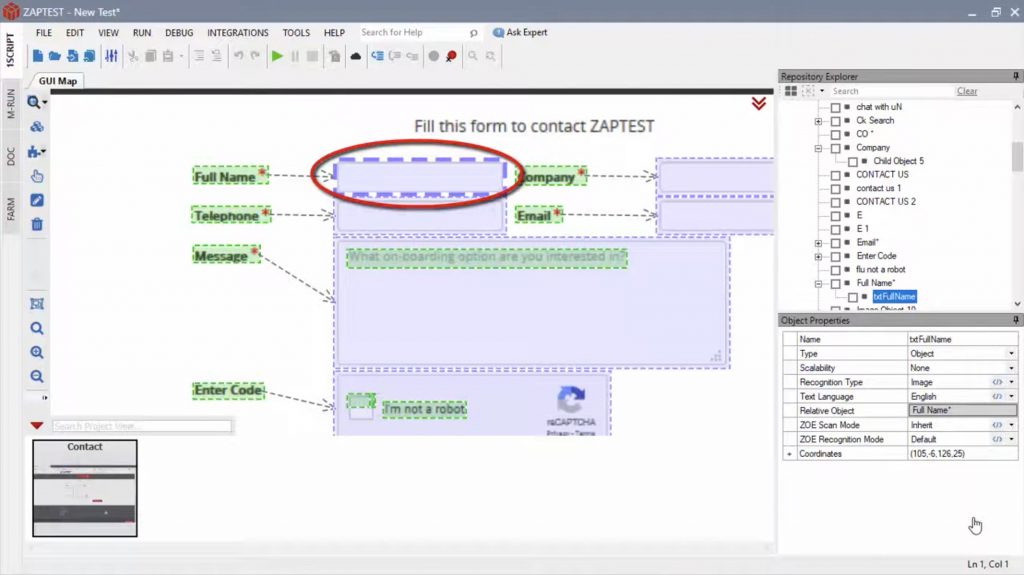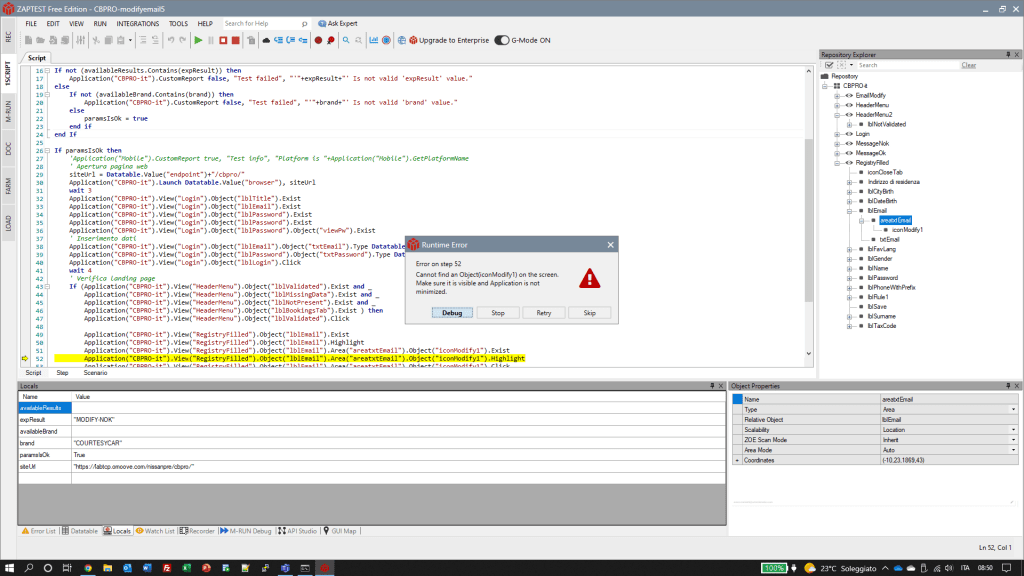Mutation testing, or program mutation, is a white-box testing technique that helps companies develop a range of new software checks while also auditing a project’s current processes. This is a relatively new approach, one that ensures both developers and testers are working to a high standard.
An application is only as successful or as good as its own quality assurance procedures – meaning it’s essential that organizations embrace more than one type of testing technique.
Learning about mutation testing could help testing teams increase their skills and general repertoire – allowing them to improve the reliability of these checks. Mutation testing is a complex and sensitive process, so it’s vital that testers thoroughly research the benefits, challenges and third-party programs which can guarantee a successful implementation.
In this article, we look at mutation testing and how it improves quality assurance, as well as other key considerations for software testing teams.
What is Mutation Testing in Software Testing?
In the context of software, mutation testing means when a quality assurance team deliberately introduces bugs – or ‘mutations’ – into an application’s code to see how the team responds. The goal is to create an error and make sure the testing suite is able to identify every alteration to the application.
When editing the program’s code, a mutation tester may switch a true/false expression, delete a statement, or simply change a value. These errors could manifest in a number of ways during other software checks; all of which are easily detectable by a skilled and experienced testing team.
The mutations themselves are often very minor, allowing the tester who mutates the code to observe how the team discovers these changes. Significant changes would be obvious at even a cursory glance – so minor errors are typically the best way to ensure the company is employing robust testing practices.
This technique specifically looks at the effectiveness of a team’s test cases; the documents containing the test information. The team may also use third-party automation software to run these checks, in which case mutation testing looks at how well this platform can detect faults within the program’s code.
1. When do you need to do Mutation Testing?
As the aim of mutation testing is to validate and improve the current quality assurance checks, it’s essential for teams to conduct this early in the testing stage. This means if the testing suite is unable to identify and ‘kill’ the mutants, there’s enough time to make sweeping changes of any scale to the organization’s test procedures.
As this is a highly versatile method, mutation testing is applicable for virtually any type of software including web, mobile, and desktop programs. This works best during the unit testing stage – which examines an application’s smallest components.
2. When you don’t need to do Mutation Testing
There are still some scenarios where mutation and general white-box testing aren’t appropriate for a program; this can be due to various reasons.
For example, if the testers are only aiming to check with black-box testing – in which case they would instead focus on the front-end for that session or even the overall testing stage.
There are some companies that consider white-box testing to be tedious and time-consuming, which could result in them skipping the process. Strong, well-checked test cases may also circumvent the need for mutation testing as this shows the team’s diligence and commitment to accurate test procedures.
3. Who is involved in Mutation Analysis?
There are a number of different roles involved in mutation analysis, including:
• Mutation testers
They mutate the code by introducing various minor defects to ensure the testing process is working as expected. These testers are usually pre-existing members of the quality assurance team.
• Application testers
They check the code regularly for any problems, identifying and correcting any mutations that they find. They conduct white-box testing to find coding errors – but also use other techniques.
• Application developers
They design the program’s features and write the initial code. They also fix any issues that testers find, ensuring that the software is in a stable state for release.
• Project managers
They offer direction on the application and may work alongside the mutation testers to see the efficacy of their own teams. They ensure strong standards across every stage of development.
What do we test with Mutation Tests?
Mutation testing focuses more on testing processes instead of the application. To this end, it examines the following:
1. Test cases
Test cases are documents that contain detailed information on every test, including the results that testers expect from every individual check. Consistent and accurate test cases provide QA team members with an idea of the application’s health and how its performance suits the firm’s expectations.
The information in these test cases can determine a tester’s ability to spot certain defects – including those that mutation testing induces.
2. Testing standards
Mutation tests closely examine the current testing procedures to ensure that team members can identify even minor issues that could affect a user’s perception of the software.
The diligence and competence of the testers might even be the main factors that a business assesses with these checks. Without strong attention to detail at every stage, testers could miss serious mutations that are present within the program.
3. Individual units of code
Mutation tests are common during the unit testing part of development. This looks at individual components to maintain a strong focus on every test, significantly optimizing the entire process by making sure testers only work with the relevant lines of code.
As mutation tests are often early in the quality assurance stage and could be a precursor to full-scale testing, this approach can increase speed without compromising on accuracy.
4. Program updates
Software updates usually involve restarting the test process to make sure that there are no new faults and that previous errors don’t re-emerge.
Repeating mutation tests is a key part of this and helps to promote consistent testing standards after major software changes.
The testing team might consider thorough post-update checks unnecessary, but code mutation can ensure they understand the importance of testing throughout every stage of development.
5. Automation software
Companies also conduct mutation testing to inspect their automated testing suites and make sure they’re able to notice mutated code, among other issues.
If a third-party testing application can identify external changes to a program and potentially even fix it, this means the organization can trust the software to automate tests.
It’s essential that firms validate their automation approach; this gives peace of mind to every tester.
6. Automation strategy
How the company integrates automation into its processes is just as important as the software they employ; for example, it may decide to implement hyperautomation. This lets the company intelligently decide which mutation and software tests to automate.
Without a strong automation strategy that accommodates the sheer variety present within an application’s code, some tests might be incompatible with automation – which limits the platform’s abilities.
7. The application
While mutation testing focuses on the testing team more than the application, it might still highlight significant information about this program.
For example, mutation testing shows how software responds to changes in its code, including if it signposts these problems in the way that the team expects.
This approach is not a software testing technique but is still able to offer interesting data about its internal operations.
Lifecycle of Mutation Tests
The usual lifecycle of mutation testing is as follows:
1. Requirement analysis
The first step of any mutation testing lifecycle is to figure out exactly what requires validation and which pieces of the application’s code would most benefit from these tests.
The team may talk to developers and executives to determine their concerns and begin addressing them.
2. Test planning
The testers then begin developing the exact checks that they intend to implement – in this case, the mutations that will offer the best insight.
This stage determines the overall mutation testing strategy and how the team is going to effectively implement their intended code mutations.
3. Test case development
Mutation testing involves its own separate test documentation, including information about the mutated code and how they expect testers to fix the issue.
Good record-keeping ensures the tests all proceed as planned and can help the team maintain its commitment to high testing standards.
4. Test environment setup
The testers make sure the application is ready for them to change – and that they have a procedure to address these issues if other team members are unable to detect them.
As part of this, the mutation testers establish a test server and use this as the canvas for their mutations.
5. Test execution
After completing their preparations, the testers change the code across several components of the application; they then wait for other testers to notice and fix the problems.
Both the mutation testers and app testers must document this extensively to make sure their records are robust.
6. Test cycle closure
Once testing is complete, the mutation testers double-check that all the changes they made are fixed either by the app testers or themselves.
They then close the test cycle and analyze the results, discussing how testers responded to the various errors alongside their ability to correct them.
7. Test repetition
After closing the test cycle, it could be necessary to reactivate it after future software updates.
Every change to an application alters its functionality in some way, resulting in new possibilities that the team must account for in order to ensure their testing process is meticulous enough.
Benefits of Mutation Testing
There are many benefits to conducting mutation tests, including:
1. Validates the testing process
The main benefit of mutation testing is its ability to show how the company’s testers approach software – and their ability to recognize coding issues. This also ensures that the team’s test cases are comprehensive enough and cover all necessary tests.
Mutation tests examine an organization’s overall testing procedure to guarantee it works as expected.
2. Ensures strong automation
Mutation testing helps a team check if their third-party test automation platform is able to adequately identify errors within the code and address them in the correct way.
If this software fails to detect these even after the necessary calibration, it might be worth exchanging the platform for one which can easily pass these tests.
3. Good coverage
Every software testing process must be able to broadly cover the entire application to ensure every aspect gets the necessary level of attention.
Mutation testers can alter any part of a program’s code; good implementation allows these tests to encompass every major feature. This teaches testers to search for issues across the entire application.
4. Examines source code
As mutation testing involves working with the code and making direct changes where appropriate, this method could also emphasize unoptimized scripting present in the application.
Software testers may only authorize the program and conduct their normal round of tests if the software’s code is adequate; these checks allow testers to highlight potential future issues.
5. Leads to better software
Mutation testing helps make sure that the application’s testing processes suit the program’s requirements.
If a mutation analysis reveals that the quality assurance team isn’t following the right procedures or the test cases are inadequate, the testers can work to improve this. Without this due diligence, the organization may release a faulty product without realizing it.
6. Effective for different languages
No matter the language a testing team uses for their application, there are software options available that can offer high-quality mutation analysis.
This includes a number of quality-of-life features that are specific to the language, streamlining the checks for greater reliability. A bespoke approach for different languages enhances the quality of each individual test.
7. Highly accessible tools
Many of the top mutation platforms are completely open source – meaning they offer more customization and a comprehensive range of features for free or at drastically lower costs.
With fewer barriers compared to many other forms of testing, code mutation is a useful and convenient way for businesses to assess, or even improve upon, their quality assurance approach.
Challenges of Mutation Testing
This process also comes with numerous challenges, such as:
1. Requires programming knowledge
For testers to execute these checks, they must have a comprehensive understanding of the program and code, making it difficult for less-experienced testers to contribute.
A business can only test software in ways that suit the existing skills of the testers; specifically, their ability to edit an application and create a fixable coding error.
2. Not suitable for black-box testing
Black-box testing mainly involves looking at an application’s front end without inspecting its inner workings and code – this is effectively incompatible with mutation testing.
As a result, these checks are only helpful for some tests in comparison to other methods; many of which can offer far greater coverage of the entire testing stage.
3. Designing mutation tests is time-consuming
Code mutation can be a tedious process due to the team needing to find individual components that would be worth mutating. Deciding which mutations to enact may itself take a lot of time; this can be problematic when other testing types are effectively waiting for these checks to fully validate the company’s testing approach.
4. May require many code mutations
Along similar lines, complex projects naturally warrant a higher number of mutants to ensure a comprehensive testing approach. This adds more time to the mutation stage and can involve many manual changes to the app code.
Without high-quality test automation software with program mutation capabilities, this could be difficult for the testers to successfully implement.
5. Testers may not notice errors
The greatest concern that mutation testers and project managers often have when implementing these checks is the possibility of software testers (manual or automated) simply not noticing the issues.
This might require a full overhaul of the firm’s testing procedures – though this might still provide the testers with vital information about their quality assurance standards.
6. Can be memory-intensive
Mutation testing generally requires a high amount of processing power, though this can depend on the application that testers use.
If the organization has a limited number of machines or these devices have low specifications, they could struggle to run too many simultaneous mutations. This affects how many checks they can perform before the testing stage ends.
7. Reports may be information-dense
Though this mainly depends upon the interface of a team’s mutation testing tool, the reports they generate can be difficult to parse.
This means it takes time to manually sort through them and find the right test results; some programs let users customize the actual reporting process; this varies from one application to the next.
Characteristics of Mutation Tests
The main characteristics of effective mutation tests are:
1. Comprehensive
These checks cover every major aspect of the software; companies with enough resources might even design a mutation test for every regular test case.
While the exact number depends upon the organization’s capabilities and preferences, effective mutation tests cover a wide range of coded features.
2. Strategic
Program mutations should similarly follow a clear and well-planned structure that facilitates the organization’s overall testing goals.
For example, the errors they produce may approximate realistic test failures which allow the testers to anticipate these issues if they naturally occur, significantly improving the firm’s testing process.
3. Constructive
The purpose of mutation testing is to identify shortfalls in testing – showing how the team could improve their checks and fix minor errors as they emerge.
Mutation testers must prioritize ‘invalid’ mutants which affect the functionality of the software, allowing for clearer testing improvements across the project.
4. Preemptive
These checks exist to validate the team’s overall strategy; this means mutation testing works better during the early stages of development.
If the testers notice any significant flaws in their quality assurance approach, this gives them the necessary time to change their test cases to make sure they’re adequate.
5. Consistent
Mutation testing across different iterations of an application should return consistent results, while also adding more checks to accommodate software changes.
Subsequent checks must include the same attention to detail in order to maintain their effectiveness – without this precision, the mutation tests can become less accurate.
6. Subtle
Mutation tests aim to examine the quality assurance team’s ability to identify code defects through their tests and third-party platforms.
This means the tests should not be immediately obvious to everyone inspecting the software; the aim is to examine how testers respond to minor code issues.
7. Collaborative
As with any software test, code mutation is a process that commonly requires teamwork and communication to ensure its success. Maintaining a collaborative atmosphere helps avoid information silos, which may result in miscommunication – this also guarantees that every tester stays focused on the tasks at hand.
Types of Mutation Tests
The three main types of mutation tests are:
1. Value Mutation
Value mutations directly change the values within the code, changing one number or letter to another in a way that affects the application’s functionality.
For example, the tester could alter the program’s exact parameters, such as the numbers that it responds to. Mutation testers might specifically target a software’s constant values as these always remain the same during normal operations.
2. Decision Mutation
Decision mutations modify arithmetic and logical operators, effectively changing how the application responds to specific situations.
For example, switching a greater-than operator (>) with a less-than operator (<) naturally affects the program’s output. Testers may also exchange ‘or’ for ‘and’ or vice versa, fundamentally altering this software and how it interprets the information that other testers and possible users provide.
3. Statement Mutation
Statement mutations change the code’s actual statements, modifying the rules that an application uses to make its decisions. Testers may change the content of these lines, duplicate them, or even delete them to check how the mutant program impacts the software’s functionality.
These mutations change a program’s building blocks, potentially removing entire functions or otherwise preventing them from working.
Clearing up some confusion
– Mutation Testing vs. Regression Testing
Mutation and regression testing are both useful approaches to software testing – understanding each of these techniques can improve a company’s overall quality assurance.
1. What is Regression Testing?
Regression testing is when testers examine software between different iterations to make sure it still functions despite changes to the code.
Even minor changes may result in serious issues without these checks, potentially causing previous bugs to re-emerge. This generally requires automation due to the complex nature of retesting every component; many companies forego regression tests for this reason.
Testers could conduct these checks on individual units, singular components, or the whole product – the exact tests required mainly depends upon the project and its scale.
2. What is the difference between Mutation and Regression tests?
Regression testing primarily focuses on checking the program and its functionality, while code mutation instead looks at how the testers respond to problems.
The former also largely takes place after multiple iterations of a program while mutation checks can be at any stage of development – though usually in the early parts of the testing phase.
Both regression and mutation tests can deal with individual coding units and how minor changes could result in significant issues that testers must work to rectify.
3. Conclusion: Mutation Testing vs. Automated Testing
Automation is often a key part of mutation testing due to the sheer breadth of checks and units – this makes it sometimes vital for a successful and comprehensive testing process.
Companies commonly use code mutations to examine their third-party automation platform and how well it identifies problematic scripting.
Combining a thorough catalog of mutation checks with automated software can significantly increase the firm’s coverage and ensure stronger results.
Though these are two separate testing practices, they do not need to oppose each other. Integrating robotic process automation, for example, can boost a company’s mutation testing strategy.
What do you need to start Mutation Testing in software engineering?
The usual requirements for comprehensive mutation testing include:
1. A clear testing strategy
The testing team must establish a strategy for mutation testing, including which components and units are the most important to examine.
For example, certain aspects of the code may be more integral to an application’s success and functionality; the testers should make sure there are enough mutations to accommodate this.
The company’s mutation testing schedule is also a vital consideration as this ensures the testers have enough time to investigate the code.
2. No scope creep
Even with a thorough strategy that sets out the company’s approach to mutation testing, it’s possible for there to be a significantly higher number of tests than necessary.
Efficiency is paramount throughout this procedure, especially as other testing stages might be waiting for the team to find and kill the mutations. The testers must clearly define their scope before they begin mutating the code; this ensures everything is manageable within a practical timeframe.
3. Rigorous documentation
Every testing process benefits from complete documentation – often in the form of test cases that detail the individual checks and any relevant mutants.
This illustrates the team’s current progress across the tests, which is especially useful for managers and executives. Documenting each code mutation also helps testers maintain clear records regarding the changes they make.
If the quality assurance team struggles to find these mutations while testing, these documents effectively serve as an answer key.
4. Skilled testers
The testers who mutate the code must have a strong understanding of the software – including the many ways they can mutate or even break it.
Mutation testers know roughly how their changes will impact the application and how other quality assurance team members could identify the mutant code.
This generally requires a good level of programming knowledge. For mutation analysis to be effective, the software’s testers should also have well-developed skills and testing experience.
5. Automation software
Third-party automation software may be a necessity before mutation testing due to the number of checks that this process often requires. This is especially true for complicated applications with more code and features for the quality assurance team to examine.
Companies may enact these checks specifically to test how automation software responds to coding errors. This can be a core part of the firm’s trial process to decide which programs are the most useful.
Mutation Testing process
The usual steps that testers usually follow when conducting mutation analysis are:
1. Prepare the tests
Preparation is the first step of any testing process. This includes negotiating the exact checks to implement and getting any necessary approval – such as from company executives and stakeholders.
The testers must develop these checks in a way that accommodates the project timeline while still covering every major component. The team’s planning can determine the effectiveness of their code mutations.
2. Introduce mutants and faults
After preparations are complete, the testing team starts altering the code, mutating it in accordance with their plan to introduce specific faults. These errors should be relatively minor as this allows testers to gauge the rest of the team’s ability to identify coding issues.
Minor faults can also help the organization inspect the sensitivity of its third-party automation software.
3. Apply the test cases
The test cases must account for every possible point of failure in an application – this might require a rewrite if the mutant program is able to function without any errors.
A program’s test cases represent the full breadth of checks that testers conduct; each one should help testers uncover any hidden mutations and be integral to the application’s usability.
4. Compare the results
After adding mutational errors to the program and applying the team’s test cases, the team must compare the results from both the original and mutant programs.
The hope is that for every successful check in the original, there will also be an error in the mutant application. This demonstrates the abilities of both the testers and the tools they use.
5. Act upon different outputs
If there are different outputs between the original and mutant programs as the testers expect, this means that the test case can successfully kill the mutant by demonstrating its presence.
The testers can then proceed with confidence in their methodology and their ability to identify coding problems. No changes to the test cases are necessary for these particular tests.
6. Change the cases if necessary
Some code mutations might result in identical conclusions across the different programs, suggesting that the test cases are unable to successfully highlight every possible error in the application.
In these instances, the mutant stays ‘alive’ and could continue to affect the software in ways that testers have no framework to address – this leads to the creation of better test cases.
How to create mutant programs
Mutant programs are effectively identical to the original programs, except for one minor change that can impact an application’s functionality in small but noticeable ways.
Comprehensive and detailed test cases help a tester or software suite pinpoint these changes and their resulting faults. Each case the company is checking requires both an original and mutated program, showing the effects of every change in isolation.
The programs typically replicate realistic errors, such as coding typos. It’s also important for testers to avoid ‘still-born’ mutants which prevent the application from executing – this is too obvious to testers.
What to change in a mutant program?
As with many software testing variables, the exact changes that testers make depend upon the application and its code.
There are three categories that encompass the majority of mutation tests: operands, expressions, and statements. Changing any of these can create an effective mutant program – showing how the different values or rules affect the very logic that a program uses.
These categories relate to the three main types of mutations that testers investigate; these are decision, value, and statement mutations respectively. The changes should be minor and must not entirely prevent a test’s execution.
Best practices for mutation testing
When conducting mutation testing in software testing context, there are certain practices worth following that ensure strong results, such as:
1. Maximize the mutation score
A program’s mutation score is the percentage of mutants that a team or application can successfully identify or ‘kill’.
For example, if a round of mutation testing has 40 mutants and the testers find 36, the mutation score is 90% – the team’s goal is always to ensure a score of 100%.
2. Choose mutants randomly
While it can help to prioritize certain components and test them more thoroughly, it’s also useful for testers to randomly select which mutants to add – especially on a tight deadline.
So long as these checks represent every significant type of mutation, the quality assurance team can validate their overall software testing strategy.
3. Keep the changes small
The code mutations should represent minor deviations from the original program as this illustrates how likely a tester is to identify certain errors; minor coding problems also demonstrate how sensitive their software is.
It’s vital that mutation testers find a balance that allows these minor changes to still produce noticeable faults.
4. One mutation per program
Mutation testing looks at individual test cases in isolation to inspect how comprehensive they are. To help with this, every mutated program should only have one change from the original.
Programs with multiple mutations may not be able to effectively pair with test cases; the mutations may conflict with one another.
5. Carefully consider automation software
Companies often use code mutation to validate the team’s use of automation software and make sure that it’s able to identify errors as effectively as a human tester.
This means selecting the right automation platform can be an important consideration, as well as the possibility of integrating robotic process automation.
6. Use test-driven development
Test-driven development (TDD) refers to a specific technique that takes testing requirements into account at every stage of development.
This helps ensure the test cases are fully compatible with the software – allowing it to easily pass mutation tests and make a better program that synchronizes with quality assurance processes.
Types of Outputs from a Mutation Test
There are several outputs that mutation tests generate, including:
1. Mutant program
The mutant programs are a natural output of these checks; the testers create these to reflect their current test cases and the issues they help detect. The programs usually only deviate from their original counterpart in one minor yet significant way to ensure greater reliability.
2. Alive or dead mutant
After the tests, a mutation is either ‘killed’ or remains ‘alive’ – this simply refers to whether the tester (or their software) successfully identifies a coding issue or not.
If the mutant stays alive, the test cases might be in need of serious changes.
3. Mutation test case
The quality assurance team uses separate mutation-specific test cases that log information about their mutant programs.
This helps to ensure the team has comprehensive records for every check; these documents include details about the mutations and their effects on the program.
4. Mutation score
The end-goal of any mutation test is to reach a mutation score of 100% with the company’s testing procedures successfully locating and killing every mutant. Anything less than this suggests that their test cases and general processes require improvement to identify problematic code.
Mutation Testing examples
Here are three examples of mutation testing:
1. Value mutation example
Value mutations involve changing a constant or parameter which can potentially alter the program’s limits. For example, an automated checkout machine’s software may use a food item’s weight to determine its price.
The testers might mutate the code behind this program to change the weight parameters, making food much more expensive per every ounce or pound. The tester or test platform should be able to identify the different value’s effects upon this program.
As this error alters one of the software’s main features, the test cases should notice this error and alert the team.
2. Decision mutation example
Decision mutations involve changing an arithmetic or logical operator, reversing or otherwise altering how this application responds to user input. Returning to the example of a self-checkout, these machines can flag up an item with an unexpectedly high weight, possibly due to a user error.
The machine’s code could do this through an “if (a>b)” decision – with ‘b’ reflecting the expected weight, and ‘a’ corresponding to the actual weight. The team may mutate this into “if (a≤b)” which changes how the checkout responds; it would flag the item even at the expected weight.
3. Statement mutation example
Statement mutations involve changing a rule or output – this might even include deleting statements from the application altogether. These mutations might be more noticeable than others, depending on the frequency of the specific statement; it’s vital that testers select the statement wisely.
For example, a self-checkout machine may display a warning if a user tries to purchase an age-restricted item. Without the corresponding statement, the machine might crash or allow any customer to buy any item.
By mutating the statement and highlighting it to the team, testers can verify that their approach accommodates these issues.
Types of errors and bugs detected through Mutation Testing
Mutation tests mainly uncover problems within the testing process itself. With this in mind, here is a range of issues that these checks can help identify:
1. Unclear test cases
If mutation analysis reveals a low mutation score (or even any score below 100%), this suggests the team’s test cases are unable to account for every possible fault that might affect an application.
They might not be specific or broad enough to match the team’s requirements. These documents should encompass every possibility that the team may encounter while testing the software to ensure reliability.
2. Untrained testing team
Mutation tests can also illustrate the team’s abilities, including how well they personally identify mutations and other faults. If they cannot locate the mutants across the programs despite clear and detailed test cases, this is potentially due to the testers not applying these cases correctly.
Mutant programs can show issues throughout the entire testing process – this may also include unskilled or untrained testers.
3. Inadequate testing software
If a company uses these checks to inspect its own testing platform, it might find that the software cannot accurately identify or kill mutant code.
The firm may respond by investigating other choices until they find one compatible with their test cases. If the automation software fails to find problematic code, it will likely struggle to identify other issues that are affecting the software.
4. Unoptimized code
Mutation testing can reveal issues already present within the software. For example, testers may try to mutate the code but uncover critical defects themselves.
This serves as another important perspective of the program, showing that code mutation provides benefits beyond the testing process. The more testers examine this code in any capacity, the more issues the team can uncover and fix throughout the testing stage.
Common Mutation Test metrics
The main metrics that mutation tests use include:
1. Killed mutants
This refers to the number of mutants that the testers or software were able to identify, flagging their existence to ensure staff can find minor faults such as these.
The amount of mutants that the testers kill depends upon the strength of their test cases.
2. Alive mutants
Alive mutants are those that the tester or software fails to identify – showing any gaps that might exist in the team’s quality assurance strategy. If this happens, the testers should recalibrate their process and test cases to accommodate these mutants and kill them in future checks.
3. Valid mutants
This metric determines the amount of mutations that the program was able to successfully include without a runtime error nullifying the test and its effectiveness.
Valid mutants are ones that the tester and automation software can examine; this is due to the mutations being relatively minor.
4. Invalid mutants
Significant mutations could affect the application enough to make testing impractical or even impossible – so it helps to track how many ‘invalid’ mutants are present in the mutated program.
Identifying these allows testers to edit or even remove them, ensuring the checks only include valid mutations.
5. Total mutants
The number of mutations regardless of their validity is another metric that testers track; this lets them monitor the mutants and record their status.
As every mutation usually involves a separate test, the total also serves as a count for the number of overall code mutations.
6. Mutation score
The most helpful metric for mutation analysis is commonly the mutation score, which is effectively the percentage of valid mutants that the tester or automation suite was able to detect.
Anything less than 100% detection can be a sign of improper test procedures.
7 Mistakes and Pitfalls in Implementing Mutant Tests
Mutation testing is a complex process that companies must implement wisely in order to avoid serious issues or mistakes. Here are seven pitfalls that testers should work to avoid when conducting mutation tests:
1. Improper mutation scaling
Scale is an important consideration during mutation analysis, as this process exists to make sure testers identify minor faults within an application. If the mutation is too obvious to testers, this may not be an effective way of checking their ability to notice or counter software issues.
2. Invalid or alive mutations
Even at the correct scale, many mutations only offer limited effectiveness – for example, if they don’t lead to a fault, or they result in an issue that stops the application from working.
Testers should be mindful of how any coding alteration could affect the entire software.
3. Incompatible test cases
The test cases and mutations must pair together perfectly to ensure consistent and harmonious testing. When deciding which mutations to add or even while designing the initial test cases, the quality assurance team may work to guarantee that these fit together and lead to more fluid testing overall.
4. Deadlines and timetables
Testing stages vary in length but should always abide by internal company deadlines. Firms that fail to properly schedule their mutation tests may be unable to complete the process in time.
Before a project reaches the test stage, the team must ensure the testing schedule is suitably comprehensive.
5. Inadequate test coverage
Businesses may choose to implement their code mutations randomly – but it’s still important that they cover a broad range of issues.
To make sure both the testers and software can detect every type of mutant, the checks should include several value, decision, and statement mutations at minimum.
6. Using mutants to test the software
Though mutation testing offers a new perspective on an application, teams must only use this method to check their own testing process. The company needs to understand the exact capabilities and limitations of mutation testing; this technique can only succeed alongside other software checks.
7. Too many mutants
It’s paramount that companies ensure broad test coverage but they might implement too many mutants in the process. Each mutation program requires a significant amount of computational power – limiting how many an organization can conduct simultaneously.
Running too many mutations can also make it harder to meet testing deadlines.
Mutation Testing checklist, tips, and tricks
There are a number of additional tips which could help any team improve the success of their mutation testing process, such as:
1. Check programming language compatibility
Both free and paid mutation testing tools typically specialize in one coding language – making it important that the testers select a tool that’s compatible with the application and software testing platform.
The testing team should investigate many options to ensure they use a program that suits their budget as well as their preferred coding language.
2. Distribute tests wisely
Different members of the testing team will likely look at different aspects of the application, usually correlating to their specific strengths, weaknesses, and overall experience.
When the team assigns mutation tests to every tester, they should keep this in mind to get an idea of their proficiency; this shows how well further testing will likely go.
3. Choose faults carefully
If a recent iteration of the software had a bug involving a value or statement, it might help to replicate this and examine how the team or program responds.
This helps to guarantee the application’s longevity and illustrates the team’s ability to notice previous errors if they recur – this is a key component of regression testing.
4. Maximize computational power
As mutation checks may take a lot of computational power to run, it helps to make the most of the company’s hardware.
For example, if certain machines have stronger specifications, it could be helpful to run the mutants on these devices. This allows the firm to avoid any significant delays which slower machines could lead to.
5. Don’t dismiss alive mutations
Even with a strict schedule, testers should work to modify and broaden their test cases to combat any mutants that survive the process.
Whilst these errors may not seem significant if the software or tester doesn’t uncover them, they still represent a failure of the test cases to identify all coding problems.
6. Investigate new automation software
If the team’s test cases are sufficiently detailed but their automated testing suite cannot successfully use them to identify each mutation, they might benefit from different software.
There are many free and paid platforms available, and companies should check every option to make sure they have the software which best suits their test cases long-term.
7. Synchronize every testing process
Collaboration is a core component of every testing strategy – this helps make sure that each process can easily fit together as the team intends.
For example, the testing team could develop their test cases with mutation in mind to ensure a greater level of compatibility, making it easier for the testers to validate their strategy.
8. Use unit testing
Unit testing lets the quality assurance team inspect pieces of code in isolation, massively streamlining the tests and making it easier for teams to identify issues.
This combination can be especially helpful if the testers worry about deadlines, giving them an opportunity to simplify their checks and improve overall coverage – leading to much stronger software tests.
9. Write detailed test cases
Mutation test cases should contain adequate information about the mutant and its effect on the program as well as how the testing team or platform located these faults.
By providing as many details as possible, a tester can personally validate the test case and make sure the team knows exactly how to ensure smooth testing.
5 Best Mutation Testing Tools
There is a wide range of tools available that can help companies with their mutation testing requirements. As is often the case with software testing applications, the prices and features vary from one platform to the next, making it vital that organizations choose the one that best fits their needs.
Some of these programs could offer free counterparts or be entirely open source; though paying for greater convenience is usually necessary.
With this in mind, here are the five best tools for mutation testing.
1. Stryker
Stryker specializes in JavaScript mutation, streamlining this process significantly to guarantee no false positives and lower the overall amount of effort that testers would otherwise need to apply for all mutation checks.
The Stryker platform intelligently assesses the software and uses the information it collects to figure out the strings or segments of code which would benefit from mutation. This application comes with a clear-text reporter that outputs a summary of the mutant, including if Stryker was able to kill it.
2. PITest
PITest is a very popular choice across the world due to its ability to change Java byte-code and make thousands of mutations per second. This application uses test case coverage data to instantly learn which tests could kill a mutant.
It only runs tests that it knows will be relevant, limiting the computational power that this procedure usually consumes. PITest is also compatible with most forms of the Surefire unit testing plugin but can struggle with effectively managing test order dependencies.
3. Insure++
Insure++ has many testing capabilities, including mutation analysis, allowing the platform to spot ambiguities in a program. In a departure from conventional mutation testing, Insure++ forgoes generating faulty mutants and instead creates functionally equivalent mutations that match the project’s source code.
This is to avoid implicit assumptions that can inadvertently limit the testing process and may not reflect realistic test environments. As the name suggests, the platform is mainly compatible with C++ programs, and every feature is calibrated to this language.
4. Jumble
This application specializes in the JUnit JavaScript framework, with comprehensive visual indicators of how the code responds to mutation analysis. Jumble is an open source platform and works within the byte-code of Java applications to lower the time of every test cycle.
Similar applications which exclusively use a program’s source code may sometimes take longer to perform these checks due to their recompiling process.
Jumble also makes use of heuristics to optimize mutation testing even further, making subsequent test runs simpler.
5. MutPy
MutPy supports mutation tests for Python-based applications, offering full support for high-order mutations as well as comprehensive coverage analysis. This program’s interface is easy to use during the output stage, which clearly shows users every essential detail of the team’s mutation tests.
MutPy offers many bespoke choices for testers – allowing them to calibrate this software specifically to their requirements. The platform uses Abstract Syntax Trees which provide a clear structure of the application’s source code, giving testers more confidence in their mutations.
Conclusion
Code mutation has applications for almost any software testing process, offering a number of clear benefits for companies that implement this technique – especially earlier in the quality assurance stage.
No methodology is without challenges; this means it’s imperative that organizations wisely consider the advantages of mutation analysis whilst ensuring it fits their usual software development timeline.
These mutations give testing teams a chance to examine their own approach and determine its effectiveness for locating and rectifying errors within the source code. This technique is especially compatible with automation procedures, letting firms validate the software they trust to handle their checks.
Mutation testing offers a comprehensive way for quality assurance teams to develop a better understanding of their own processes and software, including the issues they would otherwise fail to detect.
As a result, it’s vital that testing teams closely investigate this technique to assess if it matches the organization’s needs – including if the mutation tool they choose is fully compatible with their programming language. The ZAPTEST automated testing software boasts many features that allow it to pass mutation tests, ensuring teams have full confidence in its abilities.
Both the Free and Enterprise versions offer a high-quality testing process that can accommodate code mutations with ease.
FAQs and Resources
1. Best courses on Mutation Testing
Online courses can help first-time testers learn the basics of code mutation or strengthen the pre-existing skills of experienced quality assurance staff members. General software testing lessons can also offer many benefits to testers. The best online courses for mutation testers include:
• PluralSight’s ‘Mutation Testing in Java with PITest’ looks specifically at how to change Java code and the ways this approach could benefit practical software testing processes.
• Udemy’s ‘The Complete 2023 Software Testing Bootcamp’ is an especially up-to-date course that illustrates every key component of software tests, including white-box testing.
• Alison’s ‘Software Testing – Condition Coverage and Mutation Testing Strategies’ is free and closely examines how to wisely implement mutation testing.
• PluralSight’s ‘Unit Testing Fundamentals’ explores the benefits and features of unit testing, helping to ensure students understand the exact process for writing strong unit tests.
• Udemy’s ‘Introduction to Unit Testing’ is another free course that delivers a clear breakdown of unit testing as well as the importance of test-driven development strategies.
2. What are the top 5 interview questions on Mutation Testing?
There are a number of questions that firms can ask candidates during an interview to verify their experience or understanding of mutation testing alongside its core principles. This allows a company to make sure they hire a qualified tester that can approach different mutation-related scenarios with ease.
The exact questions vary but might include asking for their own opinions or for examples of their code mutation skills.
The top five mutation testing interview questions are:
• Which mutation testing tools do you have previous experience with, if any? What were the main features of this software?
• Whilst undertaking code mutation, how would you work to ensure a healthy balance between testing speed and depth?
• In which situations would mutation analysis be impossible? How would you inspect the testing procedure in these scenarios?
• If a value mutation manages to survive the test process, what would be your course of action to prevent this happening again?
• What information would you include on a mutation test case in order to guarantee your colleagues have the data they need?
3. Best YouTube tutorials on Mutation Testing
Free tutorials, webinars, and other videos are available on YouTube to help enhance a tester’s understanding of mutation testing. Some of the most helpful videos and series on the subject include:
• Software Testing’s ‘Mutation Testing for Programs’, which provides practical examples of how code mutation helps programs, alongside how to write thorough test cases.
• Devoxx’s ‘Mutation Testing: Did my test break my code?’, which looks at how mutation analysis improves the overall testing procedures for all kinds of software projects.
• NDC Conferences’ ‘Kill All Mutants! Intro to Mutation Testing’, which investigates how testing suites are able to benefit from code mutation and the faults it helps create.
• GOTO Conferences’ ‘Mutation Testing in Python’, which specifically examines how Python-based applications can apply mutation analysis to reach specific testing goals.
• Diego Pacheco’s ‘Java Mutation Testing With PITest’, which similarly illustrates JavaScript software uses code mutation – with a focus on the PITest mutation program.
4. How to maintain Mutation Tests?
Combining mutation analysis with regression testing and other long-term strategies allows companies to ensure a strong standard of quality assurance even after release.
Subsequent updates can lead to code changes that require further checks. Mutation testing shows that the automation software and testers are consistent across different versions of the same software, re-authenticating their particular approach.
New functions necessitate newer test cases, especially if these features interact with pre-existing ones.
In addition to this, the use of test-driven development allows team members to plan for the software’s longevity and test compatibility as part of its own development cycle.















